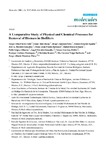Mostrar o rexistro simple do ítem
A Comparative Study of Physical and Chemical Processes for Removal of Biomass in Biofilters
| dc.contributor.author | Flores-Valle, Sergio Odín | |
| dc.contributor.author | Ríos-Bernÿ, Omar | |
| dc.contributor.author | Chanona-Pérez, Jorge | |
| dc.contributor.author | Fregoso-Aguilar, Tomas | |
| dc.contributor.author | Morales-González, Ángel | |
| dc.contributor.author | Prado Rubianes, Óscar Jesús | |
| dc.contributor.author | Herrera-Bucio, Rafael | |
| dc.contributor.author | López-Albarán, Pablo | |
| dc.contributor.author | Morales-González, Ángel | |
| dc.contributor.author | Garibay-Febles, Vicente | |
| dc.contributor.author | Godínez Domínguez, Enrique | |
| dc.contributor.author | Kennes, Christian | |
| dc.contributor.author | Veiga, María Carmen | |
| dc.contributor.author | Mendoza-Pérez, Jorge Alberto | |
| dc.date.accessioned | 2014-10-30T12:37:59Z | |
| dc.date.available | 2014-10-30T12:37:59Z | |
| dc.date.issued | 2011-08 | |
| dc.identifier.citation | Flores-Valle SO, Ríos-Bernÿ O, Chanona-Pérez J, Fregoso-Aguilar T, Morales-González JA, Prado-Rubianes OJ, et al. A comparative study of physical and chemical processes for removal of biomass in biofilters. Molecules. 2011;16(8):6927-49 | es_ES |
| dc.identifier.other | doi:10.3390/molecules16086927 | |
| dc.identifier.uri | http://hdl.handle.net/2183/13751 | |
| dc.description.abstract | After 6 months of operation a long-term biofilter was stopped for two weeks and then it was started up again for a second experimental period of almost 1.3 years, with high toluene loads and submitted to several physical and chemical treatments in order to remove excess biomass that could affect the reactor’s performance due to clogging, whose main effect is a high pressure drop. Elimination capacity and removal efficiency were determined after each treatment. The methods applied were: filling with water and draining, backwashing, and air sparging. Different flows and temperatures (20, 30, 45 and 60 °C) were applied, either with distilled water or with different chemicals in aqueous solutions. Treatments with chemicals caused a decrease of the biofilter performance, requiring periods of 1 to 2 weeks to recover previous values. The results indicate that air sparging with pure distilled water as well as with solutions of NaOH (0.01% w/v) and NaOCl (0.01% w/v) were the treatments that removed more biomass, working either at 20, 30 or 45 °C and at relatively low flow rates (below 320 L h−1), but with a high biodegradation inhibition after the treatments. Dry biomass (g VS) content was determined at three different heights of the biofilter in order to carry out each experiment under the same conditions. The same amount of dry biomass when applying a treatment was established so it could be considered that the biofilm conditions were identical. Wet biomass was used as a control of the biofilter’s water content during treatments. Several batch assays were performed to support and quantify the observed inhibitory effects of the different chemicals and temperatures applied. | es_ES |
| dc.language.iso | eng | es_ES |
| dc.publisher | MDPI | es_ES |
| dc.relation.uri | http://dx.doi.org/10.3390/molecules16086927 | es_ES |
| dc.subject | Downward flow | es_ES |
| dc.subject | Biofilter | es_ES |
| dc.subject | Backwashing | es_ES |
| dc.subject | Air sparging | es_ES |
| dc.subject | Biofilm | es_ES |
| dc.subject | Clogging | es_ES |
| dc.subject | Batch assay | es_ES |
| dc.subject | Filter bed | es_ES |
| dc.subject | Biomass control | es_ES |
| dc.title | A Comparative Study of Physical and Chemical Processes for Removal of Biomass in Biofilters | es_ES |
| dc.type | info:eu-repo/semantics/article | es_ES |
| dc.rights.access | info:eu-repo/semantics/openAccess | es_ES |
Ficheiros no ítem
Este ítem aparece na(s) seguinte(s) colección(s)
-
GI-BIOENGIN- Artigos [106]






